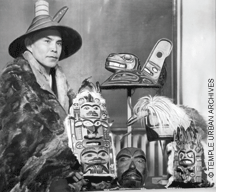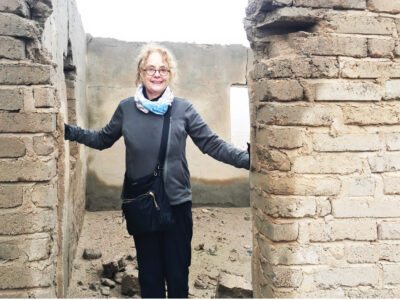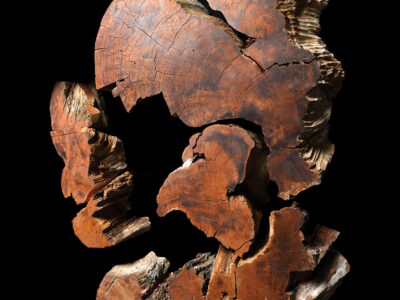“As Tlingit Indians, we believe that our ancestors’ spirits stay within any objects they owned. That makes those objects very precious to us; they’re an important part of our cultural functions, and they belong with [our] clan.”
Those sentiments, voiced by Marlene Johnson—a Tlingit Indian of the T’akdeintaan clan in Alaska—make the whole issue sound so straightforward. The Tlingit Indians don’t have many artifacts left, she goes on to say, since about 80 percent of their main community burned down in 1944. “We have a lot of objects that have been duplicated from the originals that burned,” adds Johnson, who also serves as chairwoman of the nonprofit Huna Heritage Foundation, “but we lost a lot, so anything left has become all the more precious to us.”
Here’s the problem: The objects she’s talking about—a collection of 45 artifacts ranging from a shaman’s headdress to a ceremonial rattle—have belonged to the Penn Museum for 87 years. And museum officials believe the collection should stay put just as strongly as the Tlingit believe it should be repatriated.
The debate over ownership is more complex than it appears at first glance.
The 1990 Native American Graves Protection and Repatriation Act (NAGPRA) provides a legal process for Native American tribes and clans to lay claim to their ancestors’ human remains, funerary objects, objects of cultural patrimony, and sacred objects that are currently owned by federally funded museums. The Penn Museum has received several NAGPRA requests to repatriate Native American artifacts over the years. In 1996 it denied a claim from the Mohegan Tribe of Uncasville, Conn., which sought ownership of a wooden mask. After some negotiations, the tribe eventually agreed to a long-term loan contract. In 2000, the White Mountain Apache Tribe laid claim on a Mountain Spirit headdress, which the Museum turned over two years later. But this Tlingit claim, initiated by the Hoonah Indian Association and Huna Totem, has proven more complicated than the rest, going before a federal review committee this past November and leading scholars around the country to further question who should own pieces of history.
But first, a more basic question: If they’re so precious to the Tlingit, how did these items wind up in the Museum in the first place?
Louis Shotridge, a Native Tlingit who worked as assistant curator for the Museum from 1915 to 1932—and conducted three Museum-sponsored collecting expeditions among the Tlingit people in that time—purchased the T’akdeintaan clan collection of hats, robes, masks, and dance ornaments that are now in question for $500 in 1924. According to a 2008 paper by Lucy Fowler Wiliams, keeper of the American collections at the Museum, Shotridge “saw the waning of the Tlingit social systems and anticipated the loss of his people’s traditional ways of life. He too felt the onrushing tide of modernity in Alaska, and in response, devoted his life work to recording the history of his Tlingit people and to finding a safe place for clan regalia in the Penn Museum where it would be seen on a world stage.” Shotridge’s purchases stirred no apparent controversy in his time, but they have in ours. Williams noted in the same paper that one-third of the 400 objects he collected have been claimed for repatriation by five separate Tlingit entities under NAGPRA.
The Tlingit groups currently seeking repatriation of the T’akdeintaan items insist that the leader from whom Shotridge purchased them, Archie White, didn’t have authority to sell the collection without unanimous consent of the clan. The Museum has responded that as housemaster—a Tlingit elder male of high stature, analogous to a chief—White was indeed authorized to make such a sale. “That was really the core question,” says Sherry Hutt, NAGPRA’s national program manager. “Did Archie White have the right to do this? Did he speak for the clan? Was what he did authorized by the clan at that time?”
Given the clan’s shaky state back then—not to mention the 1944 fire Johnson mentioned—some scholars doubt that the items would still exist at all had the Museum not preserved and protected them for all these years. “The Museum has acted both in good faith and in public trust,” says Steven Conn Gr’94, an Ohio State University history professor, director of the school’s Public History Initiative, and author of Do Museums Still Need Objects? [“Arts,” Nov|Dec 2010]. “It’s quite likely that had Shotridge not purchased those objects many years ago, we wouldn’t be fighting over them because they would have been forgotten about, maybe even thrown away. In that sense, the Museum has served an important function for the indigenous people and for the rest of us.”
It’s a point Johnson doesn’t dispute: “There is no doubt in my mind that [the objects] were saved because of where they are. We appreciate that, and we acknowledge that.” Still, the Tlingit want them back.
Conn says he often questions the motives behind repatriation fights like this one, describing them as “smokescreens” for deeper issues. “The problems that face Native Americans have nothing to do with objects in museums,” he says. “We’re substituting fights over ceramics and sculpture for fights over a lot of other issues: politics and power and money and social justice.” The NAGPRA legislation simply isn’t enough to address such deep-seated problems, says Margaret M. Bruchac, an anthropology professor and the Native American and Indigenous Studies coordinator at the University of Connecticut. “I really believe viscerally that ancestral [human] remains need to go home,” she says, “but I also believe viscerally that old wounds need to be healed, and federal legislation is not the best way to do that.”
Many in the museum community initially feared NAGPRA. They worried that repatriated objects and artifacts would no longer be carefully protected and conserved. “Some people certainly had the sense that the best way to preserve objects is behind glass,” says Richard Leventhal, who directs the Cultural Heritage Center at the Penn Museum and—he is quick to point out—has no involvement with this Tlingit case on either side. “However, [objects covered under NAGPRA] have a cultural context to them, and as an anthropologist, I say that these objects need to be within that context. I think that the repatriation of objects within a legal context is very important, and that people will save them and preserve them if they want to.” Besides, he adds, “the return of objects to a Native American community doesn’t mean that those objects cannot by borrowed by museums for displays.”
Presumably shelving these larger questions and instead grappling strictly with the facts of the Archie White/Louis Shotridge transaction, the Museum’s repatriation committee determined last year that the 45 objects in question were fairly purchased, and that only eight of them met the NAGPRA criteria for sacred objects and items of cultural patrimony. They offered to turn those over and co-curate the rest with the Tlingit. Feeling that the offer wasn’t enough, the Tlingit brought the case to a NAGPRA review committee of six experts, who unanimously recommended in November that the University return all the artifacts to the Tlingit.
Museum officials would not offer comment for this article, but Lori Doyle, the university’s vice president for communications, says that Penn is “very disappointed with the committee’s decision, and still hopeful that we can work out a resolution with the claimants.”
Should the artifacts return to the Tlingit clan, Johnson says they might be stored at the University of Alaska or another local museum until a new Huna Tlingit museum is built. Certain shaman objects would not be put on display, she says, but “would be kept somewhere for safekeeping.” Other objects such as robes and hats would be used in current Tlingit ceremonies.
Since the NAGPRA committee offers only non-binding “recommendations” in these disputes, if the Museum and the Tlingit still can’t reach a resolution, the matter could go to a federal district court. “We’re waiting to hear what the Museum wants to do at this point,” Johnson says. “We’re hoping to work something out without needing to litigate.”
—Molly Petrilla C’06
FROM THE ARCHIVES
Museum Explorer Returns From Alaska
The Pennsylvania Gazette, May 2, 1919

Louis Shotridge, of the Chilkat tribe of the Tliknit [sic] Indians of Southwestern Alaska, long a member of the staff of the University Museum, has returned from four years’ explorations among his own people. In that time he secured hundreds of unique ethnological specimens for the Museum, having spent most of his time collecting and writing down in the native language the manners, customs, traditions and religious rites of the various tribes. It is believed that Mr. Shotridge is the first trained anthropologist who has ever done work of this sort among the American Indians using the native tongue. Chief Shotridge took all his notes in the Chilkat language and will now spend the coming months in reducing them to English and making explanatory notes, which will form unique volumes in the history of our aborigines.
Mr. Shotridge took along a phonograph to record folk-songs and especially the ceremonial chants which accompany every great demonstration of the tribe. Unfortunately, the guttural sounds did not record well, so he was obliged to commit all these songs to memory. They will be taken down at once in ordinary musical notation by an expert. There are more than thirty of these ceremonial hymns. In addition he learned more than 100 folk-songs, which will be recorded. All of these will also be recorded on the phonograph.
Mr. Shotridge says that his people are so rapidly acquiring civilized customs and manners that before long there will be left none to hand down the ancient culture. He considers himself fortunate to have been able to find enough old people in his tribe to make the records complete.
The specimens he brought back are in many instances unique and some were given because the medicine men and chiefs foresee the extinction of native culture and want the relics preserved. The collections preceded Mr. Shotridge, and most of them are now on exhibition at the University Museum. Mr. Shotridge also brought back a bride from his own tribe, a beautiful young Indian girl, whose knowledge of civilization up to the recent trip was confined to the limited metropolitan splendor of Sitka, Alaska. She will assist her husband in his coming work. At present she is a bit confused by tall buildings and automobiles, while the aeroplane exhibits have almost driven her to nervous prostration.
—The Pennsylvania Gazette, May 2, 1919




